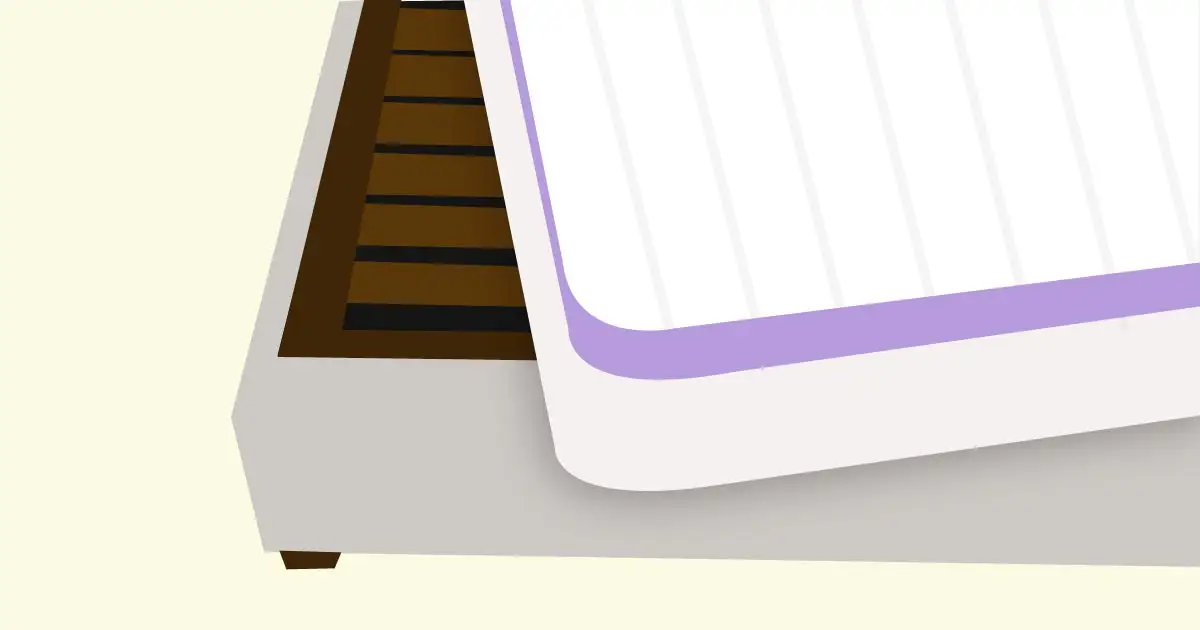What Kind Of Foundation Does Your Mattress Need?
The Concept of Foundation
Some individuals overlook the significance of a Mattress Foundation. But it’s impossible to have one without the other. A bed foundation will not only extend the life of your mattress, but it will also improve the support it provides.
The foundation is the platform on which your mattress is placed. A box spring, a wooden slat platform, or a solid base might all be used. The mattress foundation has two purposes: to support you while you sleep and to prevent the mattress from sinking, sliding, or sagging.
Your mattress will not support you properly if it lacks the proper base. To adapt for the absence of support, indents might form, leading you to sleep in unpleasant and odd postures. When this happens, you can wake up with stiff, sore muscles and joints.
There are different types of foundations on the market these days, and picking the ideal one can be difficult. Buying the improper foundation might cause discomfort and compromise your mattress’s stability, so you should know what sort of foundation your mattress requires.
Advantages of a Foundation
A foundation has the benefit of providing additional support for the mattress as well as acting as shock absorbers in the event of abnormal movement.
Gives the Mattress the Ability to Perform for You
Memory Foam, Latex, and Hybrid mattresses conform to the shape of your body while you sleep; allowing your muscles to recuperate. These beds offer the ideal balance of cushioning and support to keep your spine in a healthy, neutral position.
The mattress will begin to sink in some areas if it does not have the proper base. Your body will sink as a result, pulling your spine out of alignment. Our bodies have to compensate for the absence of support by sleeping in unpleasant postures when the spine is not straight. A solid support base, on the other hand, can help you get the most out of your sophisticated mattress.
Extends the Life of your Mattress
Putting your mattress on the proper foundation will not only guarantee that it supports you properly, but it will also ensure that it does so for many years. We spend approximately 33 years of our lives in bed, and when we are not sleeping, we are either attempting to fall asleep or sitting up in bed.
To enable this frequent usage, mattresses require a solid support structure. The appropriate foundation will prevent you from having to replace your mattress after only a few years of use, saving you time and money.
Increases the Height of your Bed
A mattress foundation may provide 16 to 23 inches of height to your mattress, and many come with the option of adjusting the height to your liking. It’s also a good idea not to raise your bed too high. Experts recommend that beds be 20 to 23 inches high from the floor to the top of the mattress, as this will make it simpler to get into bed each night and get out of bed securely in the morning.
Maintains the Cleanliness of your Mattress
Dirt, hair, dead skin cells, bugs, dust mites, pet hair and dander, etc. build on the floor, making it the dirtiest place in the house. Moisture and humidity tend to collect near the floor, which can lead to the formation of mold and mildew in the mattress.
Keep your mattress lifted off the ground to ensure that these items stay on the floor and not in your bed. The open area between spring coils in innerspring mattresses is a breeding ground for germs and grime. As a result, these beds should be kept elevated above the ground.
Latex foam and memory foam mattresses are more resistant to dust mites and microorganisms due to their density. However, foam can disintegrate when exposed to dampness. These mattresses should also be placed on a raised platform.
Enhances Airflow
One of the easiest strategies to obtain enough sleep is to keep cool and comfortable. Air will not flow adequately throughout the bed if your mattress is on the floor, causing you to overheat during the night.
The correct foundation will assist circulate air around the bed and relieve trapped heat. The correct foundation, regardless of the style of mattress you have, may give much-needed breathability so you can sleep peacefully night after night.
Maintains the Position of your Mattress
If you sleep on the ground, your mattress will most certainly move about. Furthermore, if it is built on the incorrect foundation, it may slip and sink in regions where it is not supported. A strong foundation will keep your mattress sturdy and secure, extending the life of your mattress.
Disadvantages of a Foundation
Foundations are big and heavy; they require a lot of space in the bedroom. If you don’t like or need a firm sleeping surface, foundations can be dangerous. It’s normal to wake up with body aches or headaches from staying in the same posture due to the sturdy design.
Pros
- Outstanding support
- Will not easily break down over time.
- Ideal for all types of mattresses, particularly memory foam and latex.
Cons
- Heavy
- Non-Flexible
Types of Foundations and Best Suited Mattresses
Box Spring Foundation
Steel coils are wrapped in a hardwood frame in a box spring foundation. The steel frame provides excellent stability and support, as well as acting as a shock absorber. For added freshness, the coils help enhance ventilation through the mattress’s material. A skid-resistant cloth is commonly wrapped around box springs. It acts as a lovely cover for the box spring construction and keeps dust out of the mattress. Box springs raise mattress off the ground, protecting you from dust and cold.
There aren’t many choices when it comes to box springs. These include high-quality modular grids with square coils for longer life and coil spring beds with cone-shaped wire coils for support and flexibility.
Semi-flex box springs feature a hardwood frame with a strong metal grid above slats that provide stability while only bending slightly.
Best For
Innerspring Mattress: Innerspring mattresses used to require a box spring underneath to sustain body weight. Coils bounced against each other in the two levels, evenly distributing weight and absorbing pressure.
Solid Foundation
These provide extra support. The framework is filled with a series of wooden boards to prevent sagging. Most often there are no spaces between the boards. These types of foundations are best suited for memory foam, latex foam, and hybrid mattresses.
Best For
Hybrid Mattress: A spring coil base is included in a hybrid mattress, but the foam shape necessitates a sturdier mattress foundation. This sort of mattress should be placed on a stable base.
Memory Foam Mattress: Mattresses made with memory foam are prone to sinking. You may put your mattress on a stable base before sinking in.
Latex Mattress: Similar to memory foam mattresses, latex is malleable and needs a supportive base. To avoid any drooping, consider a base with a hardwood board.
Slatted Foundation
Slatted foundations are made out of sturdy wood planks or metal beams that run across the bed frame and attach to the frame’s sides. Individual slats can be used, or they can be joined in a sequence of planks. A slatted foundation keeps the mattress in place and prevents it from drooping or slipping. They’re also simple to set up, affordable, and replaceable if one fails. Slats, on the other hand, do not add height to a bed; they merely provide support. Slats that are not properly fastened to the frame might also slide about and even fall, leaving areas of the mattress unsupported.
Slats that are too widely apart will not properly support the mattress; this is especially true with memory foam or latex mattresses, which will droop between large gaps. Slats should be no more than 3 inches apart in most cases. This spacing will give sufficient support while also allowing air to circulate across the bed.
Slatted foundations come in two varieties: curved European flexible slatted foundations and solid wood slats.
The first provides support for each sleeper independently since the slats are flexible and adapt to the size and weight of each sleeper. The latter, on the other hand, provides a more substantial feel to the sleeper while also reducing bounce and motion transmission.
Best For
Memory Foam Mattress: Memory foam mattresses have a tendency to sink. Place your mattress on a base with slats no more than 3 inches apart before settling in. Memory foam cannot be properly supported by slatted foundations with broad boards.
Latex Mattress: Latex, like memory foam mattresses, is pliable and requires a firm foundation. To avoid drooping, choose a base with narrow slats.
Adjustable Foundation
This foundation is usually tailored to each sleeper’s preferred sleeping position. To ease back, neck, hip, or shoulder discomfort, the adjustable base may be lifted or lowered. Sleepers with sleep apnea, acid reflux, snoring, edema, and fibromyalgia have been shown to benefit from these foundations.
Best For
Adjustable Mattress: You can raise the head and foot of these mattresses in your favorite positions. Without Adjustable Foundation, such mattresses can’t be used.
Platform Foundation
A platform foundation is the greatest option for individuals who want to keep a low profile. They’re small, comfy, and give off a serene atmosphere. A platform bed frame is a combination of a base and a decorative bed frame that is not only elegant but also compact and easy to transport.
Best For
Memory Foam, Latex and Hybrid Mattresses: If you have a memory foam, latex foam, or hybrid mattress, a platform bed frame is a great way to support it. As slats on foam mattresses can’t be more than 3 inches apart, it’s sometimes easier to choose a sturdy base rather fussing about slat spacing. These foundations guarantee that weight is distributed uniformly throughout the mattress and that the entire mattress is protected.
Metal-frame Foundation
Metal frames, which are equipped with elevating limbs, raise your mattress higher off the ground than a standard mattress base. It’s tough, durable, and capable of a few twists and spins. It has the following qualities: Not adaptable (or very little if it is), there are little gaps between the grids, provides a level surface for even support, a strong fabric is fastened on top of the grid structure.
Best For
Latex Mattress: Because latex mattresses are heavier than most other types of mattresses, the foundation must be sturdy and the spaces between the layers must be small enough that the mattress does not sink through.
Bunkie Board
These low-to-the-ground, compact foundations resemble box spring foundations. They’re usually made of hardwood planks and offer solid support.
Best For
Air/Water Mattresses: If you sleep on a water bed or an air mattress, a bunkie board might make your experience more enjoyable. They’re small and near to the ground, so they’ll provide extra comfort when the winds pick up.
The Last Words
It’s not difficult to choose the perfect bed frame for your new mattress—start by looking at what your mattress requires, then limit down your selections based on your budget and personal preferences. The most crucial aspect of selecting a bed frame is ensuring that it is suitable with your mattress, so as long as you keep compatibility in mind, your search should be straightforward.









